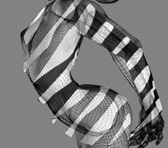28 May 2008
Dance Collaboration Merges Physical and Digital
Perth International Arts Festival // WA // 15/03/08

Creators of multi-artform works sometimes struggle with the lure and impracticalities of over-stimulation. Crowding works with one too many items of sound, light or motion can distract the audience's attention from critical details. But when a construction reaches a fine balance between its elements, these works flourish. Metadance in Resonant Light - a collaborative project by choreographer Chrissie Parrot and composer Jonathan Mustard - combines dance, music and image in a way that allows the viewer to absorb the entire show rather than be reduced to a passive observer.
Metadance is a collaboration that is primarily a dance performance featuring four dancers. These are complemented by an array of projected dancers, video and lighting effects, arranged over three movements, each set to one piece of music. The work, previously presented as an installation, took on a new life as a live performance in the dimly lit performance space of Perth Institute of Contemporary Arts. The space was divided into sections for this performance, with partially transparent drapes drawn above the stage.
Jambird is a performance company that is determined to break traditions by integrating concepts and techniques from various sources and allowing these to shape their works. The company is mainly a collaboration between Chrissie Parrot – a renowned, highly prolific, multi-award-winning dance choreographer, and Jonathan Mustard – a composer, working with computer music, mixed media and visual arts. The works they create together infuse dance with other forms of media, most recently virtual dancers. The combination of real and virtual dancers and manipulations of space, video and light in Metadance gave the overall performance an interesting new perspective and made the performance a captivating experience.
Each of the three movements had a distinctive feel and pace, exploring a particular set of visual and musical dynamics. The first movement created a digitalised world in which line after line of computer text was scrolled across the stage and images of digital dancers appeared and then quickly disappeared. The music for this movement was Nodes by the Dutch composer Martijn Tellinga – a musical setting of noise, glitches and computer fuzz. The sounds darted from speaker to speaker, rapidly changing pitch, attack, decay and volume and gave the impression of a moving and continually shifting space. The piece rose and fell in intensity as two dancers performed with their digital counterparts, copying one another, sometimes moving in sync, at other times in opposition to each other. The work combined a non-linear approach to movement with a sound world built upon incredible layers of sounds and interesting spatial effects. Perhaps more speakers would help develop the work further?
The second movement featured two female dancers who performed with their counterparts – in this case pre-recorded video footage of the dancers themselves, their shadows and reflections. The movement of the dancers generated a feeling of intense, building frustration. The choreography was lyrical and charged with emotion. The music – a 14-minute epic by the Canadian post-rock band Set Fire to Flames – reflected this, increasing in intensity as the dance gained momentum. The piece began with sparse sounds and a single organ drone and built to a multi-layered sound mass of strings, bells, organ, percussion and static noise. The overall effect of the repetition was contemplative and frustrating, reflected in the awkward and angered positions of the dancers. Finally, the piece reached a climax and faded down to a dissonant string motif.
The third movement combines and completes all the aforementioned explorations and techniques. The music, built from computer clicks and light taps, represented a more docile environment than the noisy first movement and expanded into a sea of sounds, drowning the audience in a flood of computer chatter. The visual aspect was once again aesthetically very pleasing as the dancers weaved around the stage in drawn-out wanderings. I found the shift to a French pop song in the middle of the movement problematic. It seemed completely out of context. This, however, wasn't enough to snap the viewers out of it: the audience took in the combination of visuals, sound and movement and applauded gratefully.
Overall, Metadance was a great experiment in using specific elements of dance, visuals, computer-generated images, light and music. It managed to balance each particular artform cohesively. While not all the music was original, it still proved to be a powerful and evocative score that seamlessly entrenched the listener in its sound world. If Metadance is anything to go by, Jambird will be conjuring up more dynamic multi-platform art that will appeal to a general audience as well as fans of dance.
Performance Details
Metadance in Resonant Light
Choreography by Chrissie Parrot, Visuals by Jonathan Mustard
Music by Martijn Tellinga, Set Fire to Flames and Jonathan Mustard.
Perth International Arts Festival
PICA performance space, 15 February 2008
Further Links
Perth International Arts Festival (www.perthfestival.com.au)
Jam Bird (www.jambird.com)
Jonathan Mustard (www.amcoz.com.au/composers/composer.asp?id=3346)
© Australian Music Centre (2008) — Permission must be obtained from the AMC if you wish to reproduce this article either online or in print.
Comments
Be the first to share add your thoughts and opinions in response to this article.
You must login to post a comment.